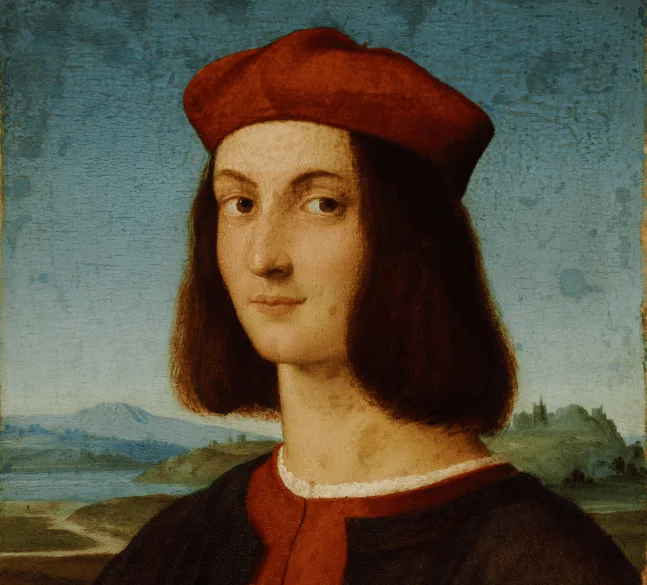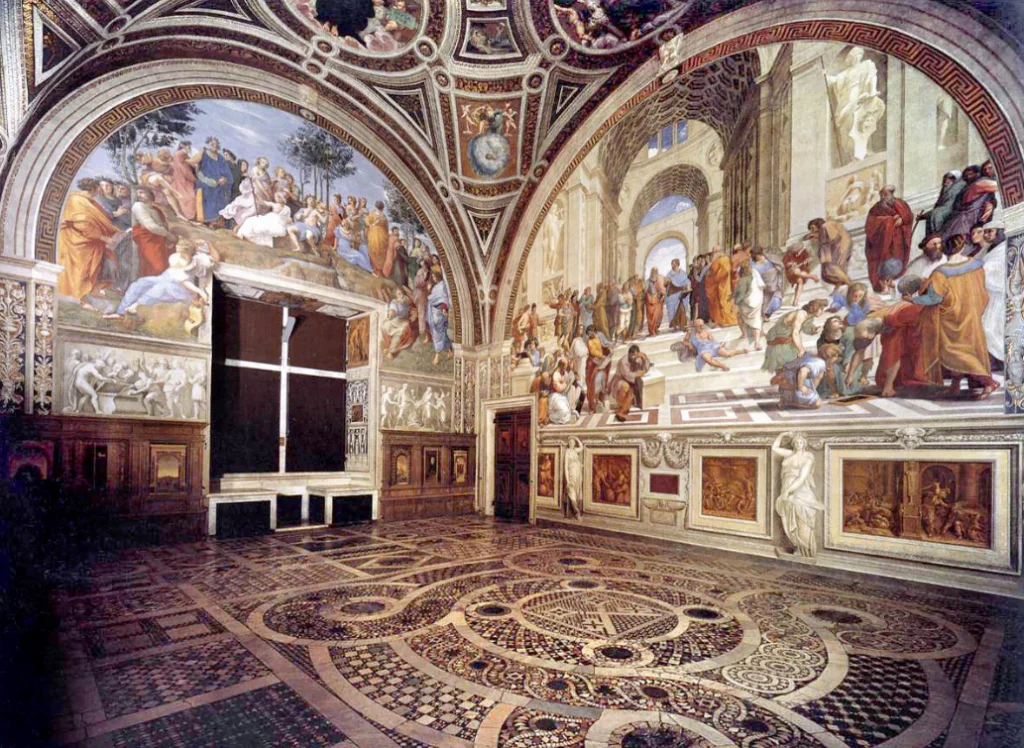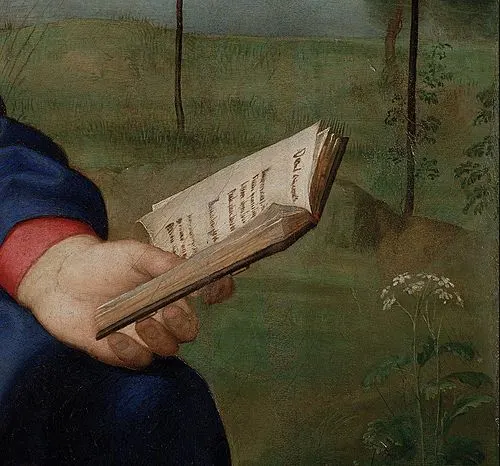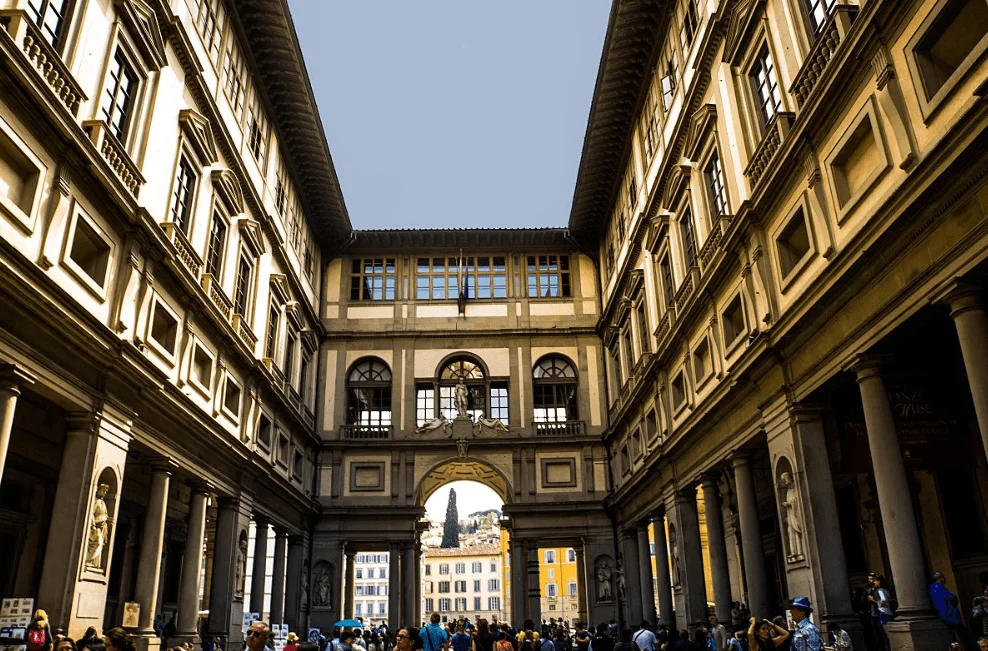This is one of the most famous paintings of one of the absolute masters of the Renaissance, and in this post, you’ll discover the ultimate list of interesting facts about Madonna of the Goldfinch by Raphael!
1. It was painted during Raphael’s Florentine period
Even though we like to refer to the period between roughly 1504 and 1508 as Raphael’s “Florentine Period,” he most probably never lived there permanently.
What’s more important is the influence his stay in this magnificent city had on the young artist, something that reflects in just about all of his following works. After all, the likes of Leonardo da Vinci and Michelangelo Buonarroti had left their permanent footprint on Florence with several masterpieces already back then.
It’s assumed that Raphael created this masterpiece around 1505-1506. As he was born in the year 1483, this also means that he was still in his early twenties when he created the painting.

2. It served as a wedding gift to one of Raphael’s friends
One of the most remarkable facts about Madonna of the Goldfinch by Raphael, which is also referred to as “Madonna del Cardellino,” is that it wasn’t commissioned by anybody.
It must have been the case that he didn’t know what gift to bring to the wedding party of his close friend Lorenzo Nasi. The man was getting married to a woman named Sandra di Matteo Canigiani on February 23, 1506, and Raphael presumably brought this painting as a gift.
Quite a remarkable present, don’t you think?
3. It’s a medium-sized painting
When we think of Raphael’s oeuvre, the first paintings that come to mind are the enormous frescoes located at the Apostolic Palace in Rome. Some of these frescos in the “Raphael Rooms” or “Stanze” are world-famous, such as “The Parnassus” or “The School of Athens.”
The latter covers an entire wall of the “Stanze della Segantura” and has dimensions of 500 × 770 centimeters (200 × 300 inches).

Raphael’s Madonna of the Goldfinch, which is an oil-on-wood painting, isn’t nearly as big with dimensions of 107 × 77 centimeters (42 × 30 inches). It’s still bigger than some of his other masterpieces though.

4. The 3 figures were painting in a geometrical design
The painting depicts the seated Mary with her son, the baby Jesus Christ, and the baby John the Baptist. These figures are a recurring theme in Raphael’s work. Some other famous works with the same theme are “Madonna del Prato,” located in the Kunsthistorisches Museum in Vienna, and the “Belle Jardinière,” located in the Musée du Louvre in Paris.
These paintings clearly show the influence of one particular work by Leonardo da Vinci, an unfinished painting called “Virgin and Child with St Anne.”
Raphael closely studied this work in Florence as it was on public display in the Church of the Santissima Annunziata back then. He used the perfect geometrical form of the figures to create an almost perfect ensemble.
Another potential influence was the famous Madonna of Bruges by Michelangelo, a sculpture with a similar geometrical form which was most probably also in Florence at the time Raphael worked on this painting.

5. The Madonna wears the typical clothes in Raphael’s paintings
Even though the painting was meant as a gift and not commissioned by the church, it still has multiple references to the Bible. One of the most prominent ones is the colors of the clothes worn by Mary.
The red is a reference to the Passion of Christ and the blue was a direct reference to the Catholic church. This was a recurring theme in Raphael’s works as well as you can see Mary wear these colors frequently.

6. Baby John the Baptist is holding the Goldfinch
The two children in the painting, Jesus Christ and John the Baptist, are still babies. John is situated on the left from the viewer’s point and Jesus is the child on the right.
John is holding the goldfinch and gently offers it to Jesus so he can caress it. This is the center point of the painting and Raphael managed to bring the viewer’s attention completely to this point using the harmonious geometrical shape.

7. The goldfinch is a reference to Christ’s crucifixion
The goldfinch is equally a reference to a Biblical story because it’s a direct reference to Jesus’ crucifixion. In this story, the red spot on the goldfinch got there while it was attempting to get a thorn from Jesus’ crown while he was hanging on the cross.
According to the legend, the red spot on the goldfinch is literally a spat of blood of Jesus Christ.
8. Mary holds a book in reference to the throne of wisdom
Another subtle detail integrated into the painting by Raphael is the inscription on the book that Mary is Holding. This inscription reads “Sedes Sapientiae,” which translates to “The Throne of Wisdom.”
Even though she isn’t sitting on a throne in the painting but rather on a rock, it’s a reference to her faith and an omen of the sacrifice her son will make to save humanity.

9. The painting was pretty much destroyed in 1548
One of the most interesting facts about Madonna of the Goldfinch by Raphael is that the painting was broken into 17 different pieces after an earthquake destroyed the house of the Nasi family in the year 1548.
It was quickly restored by a man named Michele di Ridolfo del Ghirlandaio, but this wasn’t done perfectly with the limited tools he had available.
A serious effort to finally restore the painting was started in the year 2002 following years of study. The restoration process under the lead of fine arts technician Patrizia Riitano was finally completed after a 10-year process in 2008. The team used multiple hi-tech tools such as X-rays, CAT scans, reflective infra-red photography, and lasers.
One has to wonder what kind of a job the poor man living in the 16th century could do without these tools, right?
10. The painting is located in a famous museum in Florence
Little is known about the painting the century after it was restored halfway through the 16th century. The first time it pops up in official records again was in the year 1646 when it entered the collection of Cardinal Giovan Carlo de’ Medici.
It eventually got included in the collection of the most famous museum in Florence, the Uffizi Gallery which receives well over 4 million yearly visitors. It’s still on public display here right now!

